Here we travel southwards along the Marche region's 180 kilometres of Adriatic coastline. It's not so much a route for you to follow, more a guide to the area's inviting seaside resorts.
There are basically two types of beach resort in the Marche. First there are the bigger places with a lively atmosphere, busy night-life, plenty of visitors from abroad and a string of hotels along the prom. Good examples include (from north to south) Gabicce Mare, Pesaro, Senigallia, and San Benedetto del Tronto.
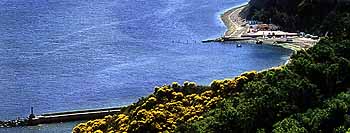
Gabicce Mare
Then there are the many smaller resorts with less spectacular beaches and more rented villa and apartment accommodation rather than hotels. These places are often filled for the short summer season by Italian families who return each year. The adults will always sigh that they're only there for the sakes of the bambini but secretly love it. And there's always the mobile telefonino so they can pretend to be in the office. Although these beaches have less obvious charms than the bigger resorts, they are often friendly places with a certain old-fashioned feel to them.
A couple of places that don't fit into either category are the handful of resorts nestling under the lone peak of Monte Conero. Here you'll find rocky coves and white limestone cliffs totally unlike any other stretch of the Adriatic from Trieste in the north to Italy's "spur" at Gargano in the south - a much more Mediterranean experience.
All the resorts in the region have a short season; basically they only feel crowded from mid-July to the third week of August. Come in mid-June or right at the end of August/early September and you'll have plenty of room with reasonably reliable weather. Most places are pretty well closed up from October through to early May.
Although all resorts have a stretch or two of free public beach (spiaggia libera), it's often at the least attractive end of the strand and is rarely as clean as the pay beaches. Anyway, if you want the real Italian beach experience choose from one of the many pay sections with their ranks of umbrellas and sun beds. They're usually not expensive, have all the facilities you could want and are the best place to see Italians up close. If you're staying at a resort hotel, free access to one of these beach concessions is usually included in the price.
All the places described can be easily reached off the A14 Bologna-Pescara toll motorway. They also all lie on or near the well-served main Milan-Bari railway line.
The Resorts
Part I - North of Ancona
Gabicce Mare
Over 100 hotels, a festive atmosphere in high season and a sandy if short strand make this one of the Marche's most popular resorts. Lying on the Romagna border of the Marche, it is in many ways an extension of the Rimini Riviera to the north. Its sandy but short strand is inviting and there is a lively night life both down by the sea and up above in Gabicce Monte where you'll find famous dance clubs and great views out to sea. Just inland is the imposing fortress at Gradara - well worth a visit with plenty of medieval atmosphere.
Pesaro
This busy provincial capital has many other attractions apart from its fine beaches and could make a good base for exploring inland historic towns as well as lazing in the sun. Its elegant broad streets have worthwhile sights to hold your attention and after a day on one of its uncrowded beaches, a fish supper by the sea is hard to beat.
At the heart of the city lies the wide main square, Piazza del Popolo. Sipping a cool drink from one of the smart bars flanking the piazza, admire the sparkling fountain in the centre. Then let your eyes wander over the Palazzo Ducale that vies for your attention with the imperious post office building. The clean-lined Renaissance palace, recently restored, was built in the middle of the 15thC by the ruling Sforza family. It now houses local government offices and an exhibition space open to the public. Leaving the square towards the sea along Via Rossini you'll find on your right the modest house where Italy's great opera composer Gioachino Rossini was born in 1792; it is now a small shrine to the composer. The annual Rossini Opera Festival in August has earned a world-wide reputation for performing works from his large repertoire of bel canto operas.
Like most Italian beaches, the 3km strand here is laid out with serried ranks of umbrellas and deck chairs but it is rarely overcrowded. For a more secluded beach with green hills as a backdrop, make for Baia Flaminia just to the north of the centre. As well as sections with all the gear where you have to pay, there are also free stretches of public beach. You'll also find free, uncluttered public beaches just south of the town on the SS16 road towards Fano.
Fano
Fano is an unassuming but lively seaside resort, a busy fishing port and an ancient town with a beguiling old centre. The Roman colony of Fanum Fortunae took its name from a noted temple to the goddess of Fortune that once stood here. Still today Fortune reigns, but in the Christian guise of the town's patron, San Fortunato. In Roman times the place was both an important port and cross-road where the Via Flaminia from Rome met the main coastal route. The Arco di Augusto, a splendid Roman triumphal arch, provides a fitting gateway to the town. It was erected in 2 AD under orders of the Roman Emperor Augustus as part of his ambitious project to smarten up the Empire's road network and marks the arrival of the Via Flaminia on the shores of the Adriatic. From here the main Via Arco di Augusto sets a course through the old centre (if you keep following the road it will eventually take you across the railway tracks to finish on the Sassonia beach).
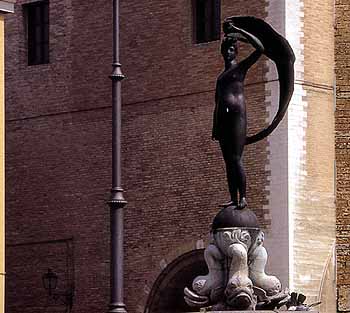
Fanum fortunae
The town has a particularly elegant passeggiata, that uniquely Italian communal stroll, in the early evening, along the town’s main streets flanked by tempting shops.
The railway cleanly splits the old town from the modern resort that has grown up along two stretches of fine beach. To the south-east runs the Spiaggia Sassonia, a long strand of pebbly beach with a wide promenade. To the north-west runs the shorter Spiaggia Lido, all sand and serried rows of beach umbrellas - the livelier of the two. Between the two beaches lies the small fishing harbour where you can buy the best from the freshly-landed catch - the vongole or baby clams are particularly good. Both north and south of Fano run pleasant enough beaches, often relatively uncrowded and with decent stretches of public sands where you don't have to pay.
Senigallia
Since 1853 Senigallia has been one of the most popular seaside resorts on the Adriatic Coast with its thirteen kilometres of golden sands, the famous Velvet Beach.
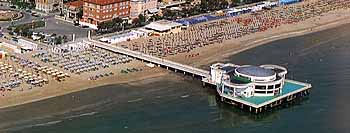
Thanks to the quality of the services it provides and the clean and safe bathing, the town has been awarded the prestigious Blue Flag of the Foundation for Environmental Education in Europe. But the sea is not the only reason for choosing Senigallia. It has a beguiling old centre and plenty of places to try the freshest fish from the Adriatic catch - an ideal base for exploring inland Marche towns.
Part II - South of Ancona
Portonovo, Sirolo, Numana
These three small resorts lie below the limestone peak of Monte Conero just south of Ancona and are probably the prettiest of the region's seaside places. Portonovo is the smallest while Sirolo and Numana between them have the most hotels and campsites. As God hasn't given them much space, they get crowded in July and August but in June and early September there's plenty of room.
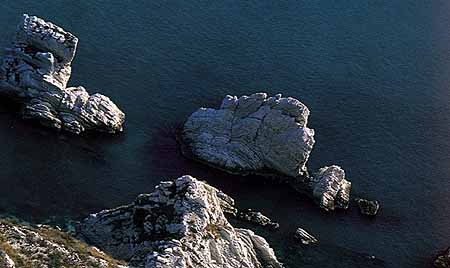
Le due sorelle - Portonovo
Porto Recanati
If you're staying inland at Loreto or Recanati, you might like to pass a day or two down here on the beach. This small-scale modern resort has an airy and spacious feel to its streets, and an attractive view of the peak of Monte Conero to the north. The beach itself is sandy gravel and rarely crowded though somewhat narrow. Most pleasant bit is the northern stretch.
Porto Potenza Picena
To the north of Civitanova is Porto Potenza Picena - very much a variation on the same theme as many of the southern Marche's smaller resorts. And as the railway actually runs alongside the beach there is no room for a promenade. A place to go if you want a day on a sandy beach and you're staying nearby.
A few kilometres inland, however, is one Italy's few remaining 18th century gardens with a beautiful red-brick noble villa at Giardino Bonaccorsi. A must if you're in the area.
Civitanova Marche
Here, too, is a small resort that also doubles as a fishing port. Although this is a family place that will probably appeal more to tourists from nearby regions rather than foreigners, it does offer a bit more style than its nearby neighbours. The more attractive promenade and beach lies to the south and has attractive planting and a calm air although the beach itself is gravel rather than sand.
Porto Sant'Elpidio
To the north of Porto San Giorgio is the narrow beach of Porto Sant'Elpidio. This resorts main attractions are its attractive pine woods at the northern end and plenty of enormous shoe shops on the main SS16 road (the place is in the heartland of the Marche's shoe industry).
Porto San Giorgio
What was once the ancient port for the inland city of Fermo is now a pleasant seaside resort with a small working port. Its streets sandwiched between the main SS.16 road and the sea offer plenty of chances for window shopping, and in high summer the place has a lively air and plenty of concerts to keep you entertained. It owes some of its charm to some fine examples of Liberty Style architecture that was much in vogue in the smarter seaside resorts across Italy at the turn of the century.
Its 13th century fortress, built by Lorenzo Tiepolo, later Doge of Venice, stands close by the town's central square, and has fine towers and high keep.
But the town's main attractions are its fish and its attractive beaches. There are plenty of moderately priced restaurants serving brodetto (the Marche fish stew) to choose from.
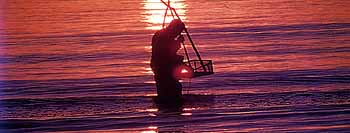
Pedaso
To the south of Porto San Giorgio is Pedaso, the Marche's "mussel beach" - these delectable molluscs are cultivated on concrete pillars that lie just off its short, gravely beach. Apart from being a popular place for skin-diving, it is also conveniently close to the motorway exit. In summer there is also a Sagra delle Cozze, or mussel feast.
Cupra Marittima
An old-fashioned seaside backwater with not too many hotels and a jolly family feel - it's a place that might bring back memories of a 1950s holiday resort in Devon. Maybe it's the lush vegetation - pines, palms and oleander - that gives Cupra Marittima its relaxed charm.

Cupramarittima
Its sandy beach (2.5kms long), punctuated by old concrete breakwaters, complements an attractive small port, and it's rarely overcrowded. It also has an interesting shell museum.
If you are looking to camp, the biggest sites are between here and Pedaso to the north.
Grottammare
The sandy beaches of this small resort do tend to run seamlessly into some less-attractive stretches of beach directly to the south. And although there are still plenty of palm trees, they are somehow not as grand as those at San Benedetto below. However, ignoring the ribbon-development along the SS.16 main road, its five kilometres of narrow strand are less developed than its sister and there are plenty of free public beaches.
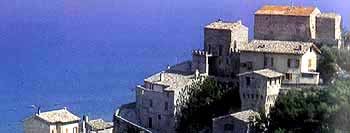
Grottammare
The pleasantest part is towards the centre of the town where a stretch of the promenade is pedestrian-only. The little historic borgo high up above the main resort is also pretty and boasts some great views out to sea. Incidentally, the 43rd parallel runs slap bang through the middle of town.
San Benedetto del Tronto
Although this is one of the Marche's most popular seaside holiday resorts, it's also a thriving town that doubles as one of the most important fishing ports on Italy's Adriatic coast. And with over 7,000 palm trees on its wide promenade, it has a touch of tropical charm.
In summer this is a popular place, but with 8km of wide sandy beach with palms trees actually growing in the sand there is plenty of space for everyone. And although it has a great deal of old-world elegance, it's also a lively place with a fun nightlife that's great if you're younger.
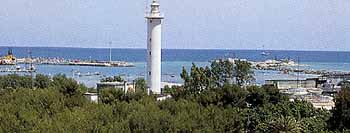
S.Benedetto del Tronto
The most pleasant stretch of beach - and the highest concentration of good hotels - runs from the centre of town southwards. The beach to the north of the large port area is less inviting although it offers many more stretches of free, public beach. The older part of the town sits above the main resort, on the far side of Corso Mazzini, with its castle and winding, narrow streets of brick houses.
Routes
Tour 1 - The Castles of Montefeltro
Tour 2 - From Paper to Stone
Tour 3 - The Vineyards of Verdicchio
Tour 4 - The Heartland of Le Marche
Tour 5 - In the Shadow of Monte Conero
Tour 6 - The Wild Mountains of the Sybil
Tour 7 - In the Footsteps of Ancient Rome
Tour 8 - Ascoli's Hidden Heritage
Tour 9 - Beside the Seaside
© Liberation Ventures Ltd.